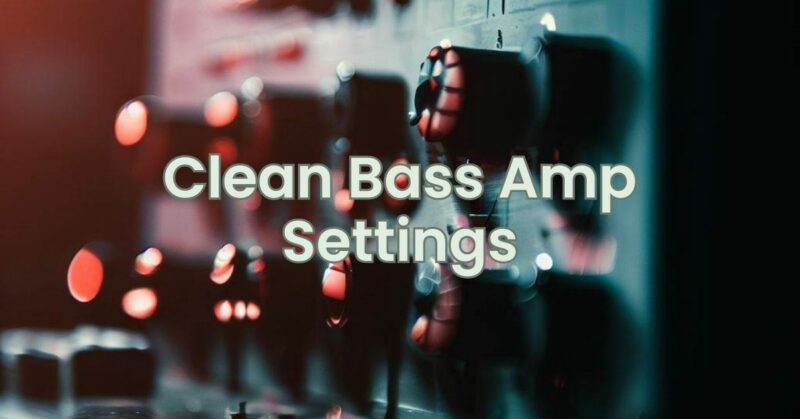Clean bass tones are revered for their clarity, transparency, and ability to provide a solid foundation in a mix. Achieving a clean bass sound requires careful attention to your amp settings and a focus on preserving the natural characteristics of your instrument. In this article, we’ll delve into the world of clean bass amp settings and provide you with insights, techniques, and tips to help you achieve that pristine, unadulterated bass tone that shines through in any musical context.
- Setting the EQ:
- Low-End Control: Start by adjusting the low-end frequencies on your bass amp. Set the bass EQ control to a moderate level to maintain a solid foundation without overwhelming the mix. Avoid excessive bass boost, as it can muddy up the sound and lose definition.
- Taming the High-End: Dial back the treble control slightly to prevent harshness or excessive brightness in your tone. This will help maintain a balanced and smooth sound, especially if you’re using roundwound strings that naturally emphasize high frequencies.
- Midrange Balance: The midrange control plays a crucial role in shaping the character and presence of your clean bass tone. Experiment with the midrange EQ to find the sweet spot that allows your bass to cut through without overpowering other instruments. A slight boost in the midrange can enhance articulation and clarity, while a slight cut can provide a more vintage or mellow tone.
- Gain and Volume:
- Moderate Gain: Keep the gain control at a low to moderate level to avoid unnecessary distortion or overdrive. Clean bass tones thrive on a clear and undistorted signal path. Adjust the gain control just enough to amplify the input signal without introducing unwanted clipping or saturation.
- Volume Control: Use the volume control to adjust the overall output level of your bass amp. It’s essential to find the balance between being heard in the mix and maintaining a clean sound. Increase the volume as needed, but be cautious not to push it to the point where it compromises the cleanliness of your tone.
- Dynamics and Playing Technique:
- Control Your Attack: Playing dynamics play a significant role in achieving a clean bass tone. Experiment with your playing technique, adjusting the strength and consistency of your attack. Avoid aggressive picking or plucking that may cause unwanted string noise or excessive transient peaks.
- Consider Compression: If your bass amp has a built-in compressor, experiment with gentle compression to even out the dynamics of your playing. Compression can help maintain a consistent level and sustain, allowing for a more controlled and polished clean tone.
- Room Acoustics and Instrument Setup:
- Room Characteristics: Remember that the acoustics of your playing environment can impact your bass tone. Be aware of how the room’s characteristics affect the sound, such as reflections or resonance. Adjust your amp settings accordingly to compensate for any room-specific challenges and optimize your clean tone.
- Instrument Setup: Ensure that your bass is properly set up, with well-adjusted intonation, suitable string action, and optimized pickup height. A well-maintained instrument can contribute to a cleaner and more articulate bass tone.
Achieving a clean bass tone requires attention to detail, a focus on preserving the instrument’s natural characteristics, and finding the right balance in your amp settings. Set the EQ to maintain a balanced frequency response, use moderate gain to avoid distortion, and adjust the volume control to fit in the mix while maintaining cleanliness. Experiment with playing dynamics, consider compression, and be aware of the room acoustics and instrument setup. By implementing these techniques, you’ll be well on your way to achieving a crystal-clear, pristine bass tone that brings a powerful and defined presence to any musical context.


